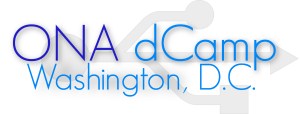 The Online News Association, the world’s largest membership organization of digital journalists, held its first all-day workshop on design thinking at The Washington Post on May 11, 2013. Twelve leaders from the ONA community walked nearly 100 people through improving their creative processes.
The Online News Association, the world’s largest membership organization of digital journalists, held its first all-day workshop on design thinking at The Washington Post on May 11, 2013. Twelve leaders from the ONA community walked nearly 100 people through improving their creative processes.
The day outlined how to create stronger products through the lens of human-centered design. The camp — part of the larger ONACamp program which offers free intensive digital journalism training sessions and is sponsored by the Gannett Foundation — broke down the design process into distinct stages: Inform, Inspire, Iterate and Implement. Speakers gave short presentations to introduce these stages, then attendees participated in group activities to build upon what they had just learned.
Journalists, designers, students and others from the D.C. metro area and all over the country came together in groups for the day’s overall goal: to build prototypes of web projects that could solve real-world problems.
Inform/Discover
Reggie Murphy, principal consultant, research and strategy for Electronic Ink, opened the day by defining human-centered design, a process that develops solutions to problems by understanding the needs, desires and contexts of people. To use this framework throughout the camp, groups needed a problem to solve, so they answered the question “How might we…” and identified one.
Kennedy Elliott, interactive designer for Guardian US, highlighted the importance of defining users before building a product for them. She walked participants through the process of creating detailed personas, including demographic information like eating habits, hobbies, political views and the way they look.
Inspire
Yuri Victor, UX director for The Washington Post, presented techniques for efficient — and fun — brainstorming. He challenged groups to come up with dozens of ideas on Post-it notes in a short 10-minute window. Groups then worked to assess and narrow those ideas.
Iterate/Build
After a lightning talk from Murphy with tips on how to build a prototype, groups used materials — crayons, construction paper, cardboard boxes and more — to build their first drafts. After rapid prototyping, each group received user feedback from a partner group.
Laura Cochran, features editor for Digital First Media, followed up with a presentation on developing a use case for your prototype and how to evaluate user feedback to create a better product.
Implement
Attendees used this final phase to continue iteration on their prototypes, folding in evolving ideas and peer feedback. Groups then took turns presenting their products to everyone in attendance. Final prototypes ranged from an audible news app, serving D.C.’s functionally illiterate population, to a virtual collaboration module and beyond.
Leaders
| Brian Boyer, NPR, @brianboyer Laura Cochran, Digital First Media, @cochranism Sara Deneweth, freelance, @sarajden Kennedy Elliott, Guardian US, @kennelliott Ali Felski, Living Social, @felskia Ted Irvine, Vox Media, @ted_irvine |
Joey Marburger, Washington Post, @josephjames Pablo Mercado, Vox Media, @odacrem Reggie Murphy, Electronic Ink, @reggiemurphy Regina Nuzzo, Gallaudet University, @ReginaNuzzo Sheeka Strickland, Medill, @Sheeka_S Yuri Victor, Washington Post, @yurivictor |
